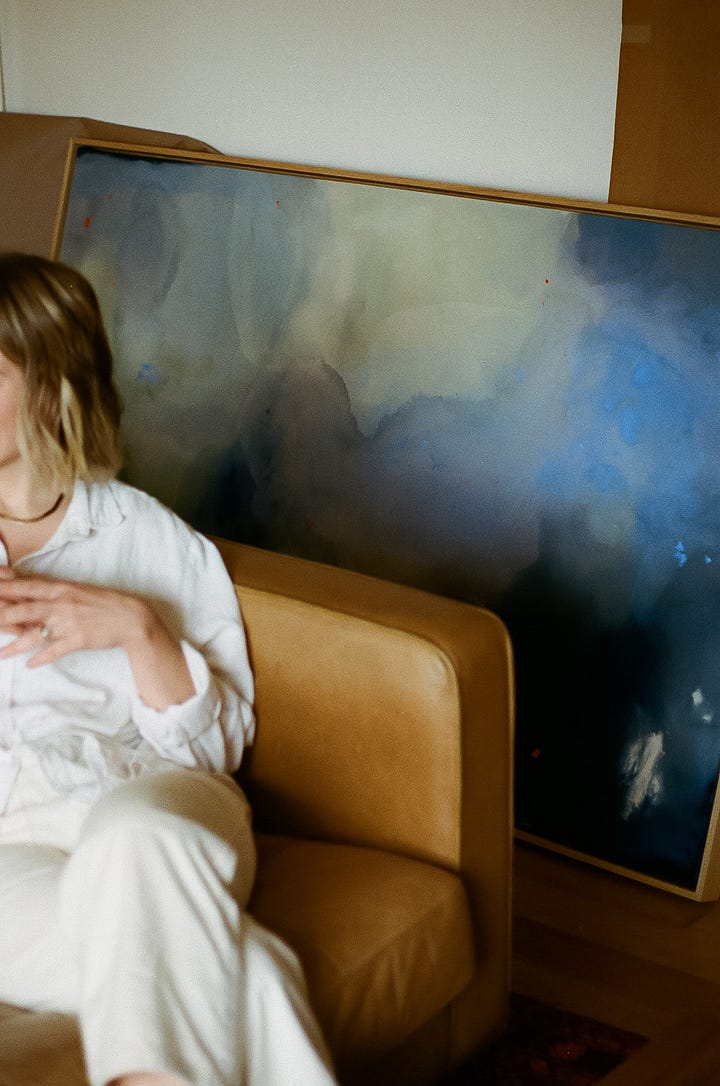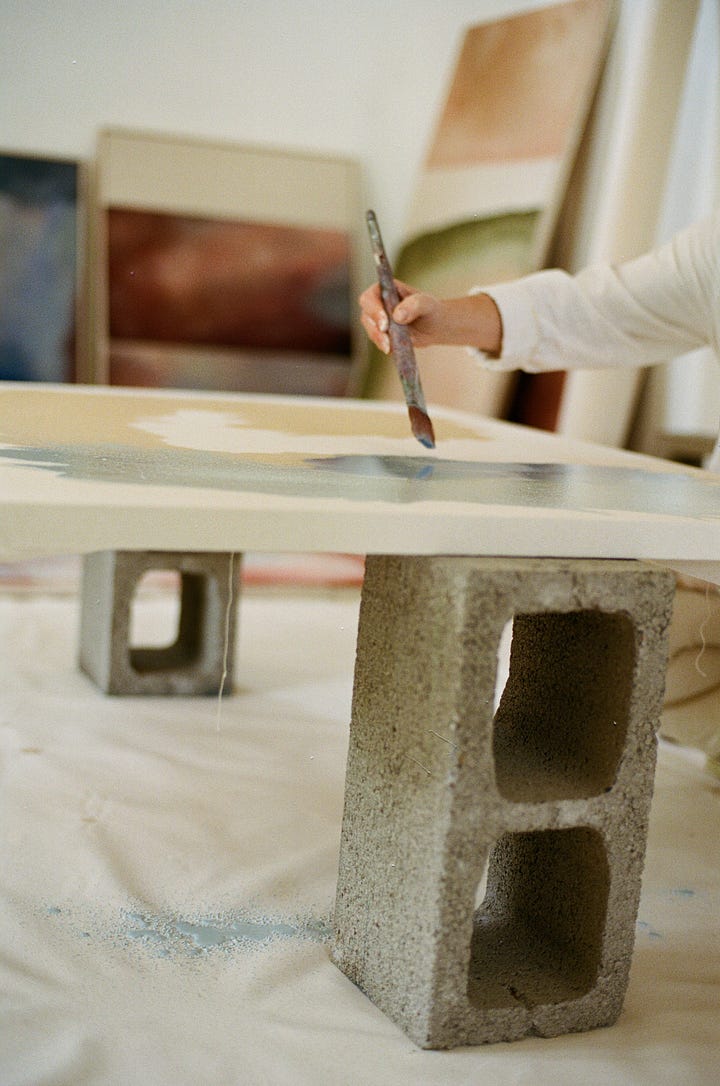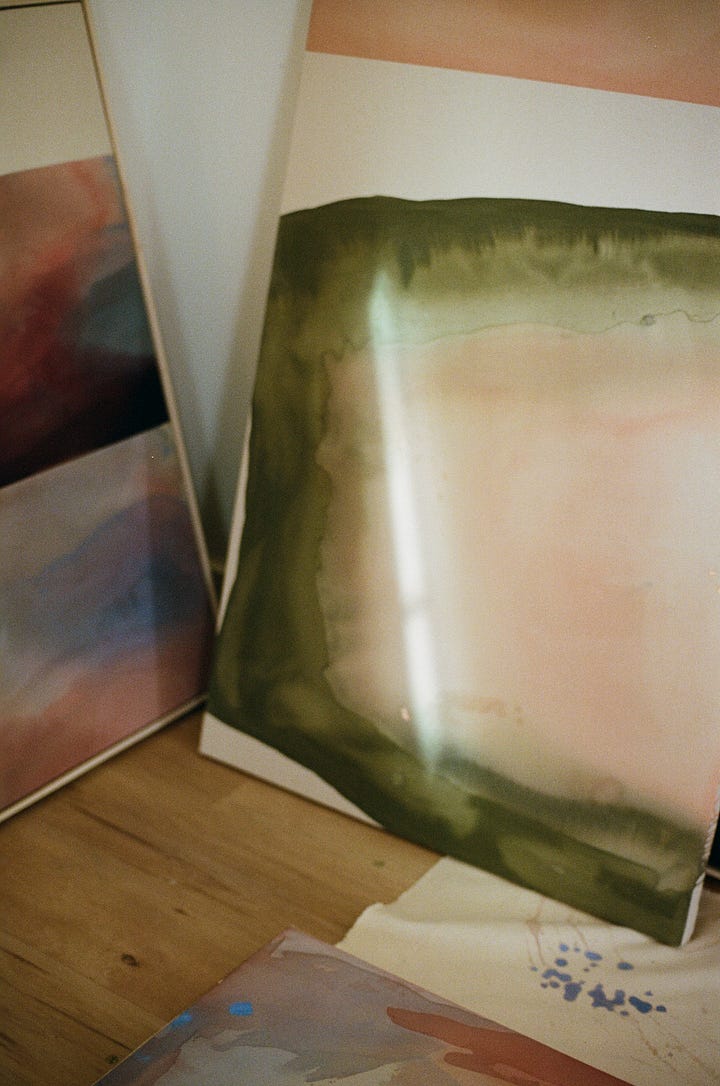Studio visit with Brenna Hodges
Painting in the abstract allows her to fully succumb to the creative process
Hi readers! I come to you today with a very special edition of Honing Her Craft, the first of its kind this year featuring Portland artists in their studios. The series, STUDIO VISITS, has been sitting in my heart for a long time as I’ve been thinking about how, often like our personal style, our spaces reflect our innermost selves on walls and in dusty corners. Little love notes to ourselves and from others, collected artwork, disheveled books and journals—together, these things combined are maps of our souls. It took finding the right partner in friend and film photographer Lauren Beane to bloom this seed of an idea.
I hope you enjoy this inaugural edition, featuring abstract artist Brenna Hodges. You can expect one every month for the rest of 2024. Interviews are edited and condensed for clarity by me, and all photos are by Lauren. Support this series and future editions by liking it, forwarding it to a friend, or upgrading to a paid subscription. —Amelia

On one of Portland’s first sunny days, it’s still too cold for Brenna Hodges to keep the doors of her studio open. She works better when it’s warm and she can spread out, moving between the converted garage and the patio of her southeast abode.
Working in abstract painting, temperature is as much of a stakeholder as the paint and the canvas in the creation. Acrylic paint mixed with water or pouring mediums dries at different times when Brenna douses raw canvas and then adds layers to her liking. “The canvas and the paint have an equal voice in the conversation because I’m playing around with techniques that I know or want to explore,” she says. “There’s also a lot out of my control that I’m responding to.”
Dressed in cream pants and a button down splattered in pastel paint droplets, Brenna is the human manifestation of the canvases stacked against the walls in her studio, which blend deep hues and soothing tones inspired by her reverence for Oregon’s coastline, forests, blooms, and seasons.
In 2022, Brenna and her husband, Brian, moved to Portland after spending the last decade in Nashville, Tennessee. The transition marked a momentous shift in how Brenna approached her art—no longer as a hobby but as a vocation.


Before moving to Portland and pursuing art more seriously, what was your practice like? And did you even consider it a “practice”?
I’ll rewind it way back. I was always super creative as a kid, which I feel like all artists say. I grew up in Northern Minnesota in a really small town at the end of a gravel road with very few neighbors. My siblings were much older. I always had to find little projects to keep myself busy. I have memories of finding flat stones from the river and painting landscapes on them. Or spending a whole day in the woods building an elaborate fort. Or taking an old pair of jeans that didn’t fit and hand stitching them into a purse. As I got older, I still dabbled in art but it was always very much a hobby. Growing up I never really saw people making a career out of art. I didn’t think it was possible, so art was something I pushed to the side. But in 2020, I started to explore art again more seriously.
How did the pandemic’s forced isolation maybe mirror some of that creative space you had growing up?
I think it was a combination of things. My husband and I had done a lot of traveling before the pandemic. The thing that kind of prompted the travel was we were both really burned out by work. He was at a design agency, I was teaching at the time. We both just felt like we couldn’t see ourselves in those roles long term, and we wanted to shake things up but we didn’t know what that looked like. So for a lot of 2018 into 2019, we lived out of an SUV along the West Coast and explored different cities and tried to tap into what we could see ourselves pursuing long term or what would feel most fulfilling to us. Art was just kind of something coming up during that time. I found myself painting and sketching on the road as we traveled. Coming back to Nashville, that’s when I got a job as an art teacher at an elementary school. That was four days a week. Having Friday was almost like permission to paint and take art more seriously and see what happened. I taught myself how to stretch canvas, and I just started playing around.
Why abstract art?
We kind of live in a society that really values optimal, maximum output and having a product or something to show for your work. I think the process itself can feel frivolous. It’s like, what do you have to show for it? That’s definitely something I’m fighting against and having to unlearn. But I think that’s why I appreciate abstract art. A lot of times when I’m starting a painting, I don’t really have a plan. So in a way, I have no choice but to succumb to the process and see how the paint takes on a life of its own. It’s a good challenge for me to get back to that childlike state of being immersed in the process, regardless of the outcome.
You’ve worked in apartments and basements that weren’t dedicated making spaces. How has this studio impacted your creative practice?
I feel like artists and creatives are good at making it work under any circumstances. Whatever space, material, resources. But I feel like once I had this space, it felt like a game changer. The fact that I’m leaving my house and coming to a space that’s solely dedicated to art just makes it feel almost sacred. It’s easier to let go when the space is yours, when the space is dedicated to art.
Are you coming out here every day then?
I notice my creative flow shift so much with the weather and the seasons. So like, the space itself is beautiful and lovely to have. But I also notice that I work a lot better on sunny days. If I can open the studio door and spill into the backyard and have a breeze flowing in and paint is drying faster, that is actually a huge shift in my creative flow. Summer can be really busy and energizing and productive. But then in January and February, I just didn’t feel very inspired and I was craving a lot of rest. Right now, I’m out here seven days a week. In January, I might go a week or two weeks without painting. I’m trying to kind of allow myself to shift with the seasons and have these ebbs and flows of busy and energetic states.


Favorite paint brand: “Golden acrylics”
A wardrobe staple: “I have these two-toned chunky loafers by Alohas. I feel like whenever I just need to elevate an outfit slightly, I’ll throw those on.”
Go-to treat: “The chocolate chip cookie from Coquine’s bakery. It’s very close to my house and it’s very good. And in the summer, the ube latte from Upper Left.”
Another artist you admire: “Always Helen Frankenthaler. She was the first woman to explore abstract expressionism.”
A simple luxury: “Going to a really nice grocery store and looking at, touching, and admiring the beautiful produce.”
Dream project: “I would love to travel and see how different places impact my practice and process. My dream would be to get into an artist residency in a dream destination like Oaxaca or Paris for the summer.”
You’re open to commissions, and you sell art at a furniture store. But tell me a little bit about your personal cadence with collections.
Initially when we moved, I was going to approach art the same way I did teaching, which was very disciplined. I was like, I’m going to paint for eight hours a day because that’s how I’m going to prove that I’m a real artist and I can make a career out of this. Then I was getting frustrated because I didn’t like any of the work I was creating. I didn’t feel inspired. I felt very drained and depleted. I was like, what is going on? Brian, my husband, was like, have you left the house today, have you done anything for you? I was like, no, I’m painting, I have a job. I think through that, I learned the hard way that I have to approach creative work very differently. A disciplined schedule might not be the most conducive to creative work. I’m trying to prioritize filling my cup first, then working.
When do you know you’re done with a piece?
I once heard when you can sit with it and look at it for a long time and just feel at peace, which sounds cheesy. But I have found when a piece isn’t finished and I’m sitting with it, I’ll just feel unsettled. It’s this very delicate dance because I’ve definitely overworked pieces thinking I want more layers, more details, and then it gets to a point where I should’ve had more restraint there. I can’t just erase.


Where you can find Brenna | Website | Instagram | Newsletter
Amelia Arvesen (she/her) is the creator of Honing Her Craft and a freelance journalist who integrates her artistic side into her every day. The STUDIO VISITS series merges her curiosity as an interviewer with her admiration of creative practices and people.
Lauren Beane (she/her) is a freelance photographer specializing in film. She values a life centered around art, nature, community, and little pleasures. This series allows her to expand her definition of what it means to live a creative, artful life while providing others a window to do the same.






Love your slant on the whole childlike state when you start an art piece. Not knowing where it will take you! I teach process art for children and it is a magical thing to watch those little people deeply immersed in their art!